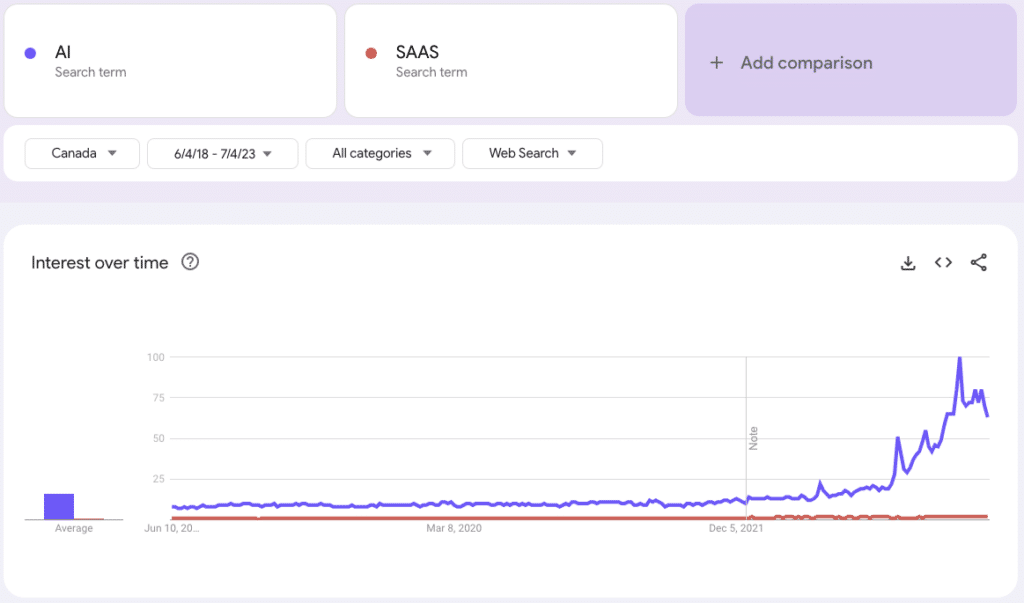When I started to think about writing this financial trends article, the letters LLM meant little to me. Sure, I knew about “ChatGPT”, but as the last few months have passed, it’s become clear. AI is a critical new factor in many (if not most) businesses; everyone and their dog has a strategy and we’re all starting to understand the potential and opportunities that come from tactful use of AI.
With AI as the leader, let’s dive into the top trends so far in 2025 facing SaaS companies.
AI
It’s obvious that AI is one of the top issues, if not the top issue facing SaaS companies today.
At best, it’s an opportunity for you to expand the functionality and value of your app; at worst, it’s a major existential crisis. Will AI replace your product?

Looking at the chart above, it’s astounding how fast market perception has shifted and the incredible hype around artificial intelligence.
There are innumerable places AI can impact a SaaS business, but the low-hanging fruit I see is as follows:
Conversational Interfaces
UI/UX was all the rage in the early days of the internet, as we slowly formed norms on the best ways to bring people through a product.
AI is uniquely positioned to cause an order-of-magnitude shift in UX. Just as increasing access to information and instant communication technology led consumers to no longer tolerate large wait times, AI is going to completely change the way customers expect to receive service, complete product discovery, and more.
Companies that can successfully harness the power of a ChatGPT style interface can replicate the value and impact of expert conversations, where a company representative understands exactly what the customer is asking for, even if they aren’t super clear in their ask.
If you’re doing it right, you can close more sales with less time and labor. If you’re doing it wrong, you’re going to lose customers to other businesses with more savvy solutions.
AI Research & Prediction
There are many ways to utilize AI research & prediction in your business. Here are a few examples of the questions to be asking yourself:
To increase your product value proposition: “Are we using LLM to better provide results in our analytical products? To synthesize data and identify patterns and trends that we wouldn’t be able to see with our biases? Are we using this executing upon this information to improve our users’ experience with us?
Or for improving your marketing and retention engines: Are we using predictions and insights to better guide our “product-led growth”? Are we using AI + our own datasets to predict what our users think and feel, then maximizing that information for improved conversions and retention?
AI Optimization in Sales
Where are you using AI to generate ad copy and image creation for audience development? How are you using it to support SDR and BDR roles with insights, language, and suggestions through the close cycle?
Instead of waiting for a packaged solution to be sold to your team, consider all of the processes that could use a 24/7 research assistant’s support, then implement it. AI introduces a massive opportunity to improve your CAC/LTV ratio, close times, and more.

When I look at the accelerating investment in AI, I think of Andy Grove’s statement: “Only the paranoid survive.” This is the single piece of advice that I believe SaaS founders and executives need to hold on to.
When I think about how to position a SaaS company in this space, the old adage “the best defense is a good offense” comes to mind. Being complacent and hoping this all will blow over is likely a critical mistake. Yes, the exact impact of AI is to be determined, but looking forward and positioning your company to make the threat into an opportunity is the most critical thing for founders to do today.
You could learn a few new insights into your business, or you could transform the very way you do things.
Equity Markets Tightening
Continuing with the more obvious trends, I’m sure we’ve all been reading about the economy and investment landscape tightening. I won’t dive into all of the details, but as you’ll know, it’s getting harder to raise capital.
The opportunity lies in accepting this and working overtime to put your company at the top of the stack. You’ll find that deals are still getting done, just at lower volumes and lower valuations.
What we’re looking at is a “flight to quality”. The early-stage asset class still exists but, with the upward pressure of rising interest rates, investors are looking for better-quality investments at mindful valuations. When the “safe” options for compounding capital dry up, the already risky investments look a lot less attractive.
While it’s tempting to get frustrated with a harder market to raise capital in, moving past this and single-mindedly focusing on identifying and improving the core metrics is critical. The complacent (dare I say, foolish) money has moved on. The capital that remains understands the market opportunity and is laser-focused on finding and investing in high-quality companies.
The adjustment is simple to see from 100,000 feet. When cash was cheap, we had excess capital and time to experiment; however now we have less rope to play with, fewer laissez-faire investors, and less time to course correct. We need to make hard decisions fast and focus on the 20% of actions that hold 80% of the impact. No more, no less.
Extending Runway
This brings me to the next point: we’re not all perfect and getting better will take time, no matter how hard we try.
Every company today should be looking at how to mindfully extend its cash runway. If you’re cash flow positive, you should be thinking about how to expand your war chest.
That next round of capital is no longer guaranteed, and it’s certainly unlikely for it to arrive in the timeline you’re expecting. Spend the time now to:
- Develop a robust cash flow model with scenarios. Update it weekly.
- Reduce cash burn.
- Reduce marginal investments and save your cash for bigger impact items.
- Improve your customer LTV / retention. Increasing CAC is always risky, and every investor loves a better gross/net retention ratio anyways.
Downsell & Churn Risk
There are going to be some new enemies at the door.
While you’re busy reducing your burn or increasing your profitability, it’s critical to recognize that your actions aren’t unique: many of your customers are doing the same thing and looking for ways to extend their own runway.
Spending the time to deeply understand your customers and what makes your product/service uncancellable is a critical theme for companies to action. Again, I think this is a place for the 80/20 rule to be used. Understand if there is a small number of attributes that can be built or communicated that avoids the largest portion of churn or down-sell risk.
There are significant diminishing impacts for churn avoidance strategies, but spending the time to identify the easiest low-hanging fruit is worth it.
Failing Companies = Revenue, Asset, & Employee Opportunities
Sadly, there will be cuts and failures in the market. However, this poses a significant opportunity for companies to acquire great employees who are laid off or acquire the assets of a failing business for a bargain purchase price.
JP Morgan’s acquisition of First Republic is a notable example of this but it’s truly happening all around us. Data from RSM shows that accretive acquisitions represented 74% of all UK buyout deal flow (by number of transactions) in 2022 alone. It’s time to look for deals before they’re all gone.
While it can be tempting to spend all of your time looking internally, you should ensure that you’re expending adequate time and attention analyzing what’s happening externally in your industry. As long as you aren’t at imminent risk of failure, there will be opportunities for you to take advantage of.
Getting your house in order now and building those cash reserves will position you best to capitalize on these events when they occur.
Stay Informed to Stay Ready
If you want to be positioned to take advantage of financial trends as they appear, you’ll need reliable sources of information to lean on. Subscribe to The CFO Club’s newsletter to stay informed and stay alert.


